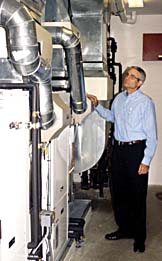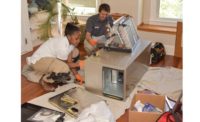
Contractors are no different. Their livelihoods are determined largely by their reputations in the community. A loyal customer base that recommends them to friends and family usually translates directly into a contractor’s success.
A strong reputation is what led Dennis Gant, president of Ramsey-Bennett, Cleveland, into the world of geothermal. He wasn’t involved with geothermal systems before, but several others knew the good work he did and encouraged him to bid on a project several counties away from his home office. He won the bid, did a great job, and is now looking forward to more geothermal jobs.

New Station Needed
Gant’s first geothermal installation took place at the Northwest Ambulance District Station in Geneva, Ohio, which opened in February 2003. This wasn’t the easiest job to cut his teeth on, because the station needed to serve two purposes for the community. First, the 8,700-square-foot building had to provide 24-hour ambulance service to residents in a 45-mile radius.Second, the building was required to serve as a “shelter in place” for emergency personnel because of its proximity to the Perry Nuclear Power Plant. Basically, the ambulance station needed to be capable of complete isolation from all outside air in the event of an emergency at the nuclear plant.
“Having an all-electric HVAC system allows for continuous operation even when all outside air openings are closed,” says Rock Taylor, sales associate with Pier Associates, Akron, Ohio. “All fresh air openings can be closed tight with zero-leakage dampers, and there are no gas appliances or flues that could create a negative pressure within the building.”
Pier Associates is WaterFurnace International Inc.’s commercial representative, and Taylor was one of the people who contacted Gant about bidding on the job. “I was very apprehensive about doing this job,” says Gant. “I said, ‘What do you mean I have to drill holes in the ground?’ I hadn’t done that before. But since Ramsey-Bennett is small and known for tackling different kinds of challenges, I thought we’d give it the old college try.”
Fortunately, Gant had good people helping him every step of the way: Taylor and Jim Kish, Engineering Elements Inc., Willoughby, Ohio, the engineer who designed the system. Gant also notes that the subcontractor who drilled the wells, Middleton Corp., Akron, Ohio, was a wealth of information.

Geothermal All The Way
There was no question that the new ambulance station was going to have anything else besides a geothermal system. The owners had done their research and liked geothermal’s energy savings, reduced maintenance costs, and consistent year-round performance without auxiliary heat.They were aware that the equipment’s first cost would be higher than air-cooled equipment, but they anticipated a significant payback, since the building was designed for many years of use as the area’s ambulance station. Pier Associates estimated energy savings over an ordinary system at 59 cents per 100,000 Btu vs. 67 cents in heating and 13 cents vs. 23 cents in cooling. The system is cooling dominant, providing even greater savings during summer operation.
“They didn’t even want to talk about air-cooled systems,” says Gant. “I told them it would be a lot of money to put in the well field. In fact, it was a solid 30 percent of my total cost (approximately $162,000) for this job. We had to drill 12 wells, 150 feet deep. We couldn’t go deeper because of natural gas deposits in the area.”
The building has four Premier water-to-air heat pumps and two Versatec water-to-water heat pumps (24.25 total HVAC tons) connected to a vertical closed loop with 12 boreholes and a total of 1,800 bore feet. The two water-to-water heat pumps service
the 2,660-square-foot four-bay garage, while the four water-to-air heat pumps service the remaining 5,000 square feet of offices, dormitories, and communal space.
The water-to-water heat pumps are looped together and feed a 120-gallon reservoir tank, which maintains a 95 degree F water temperature. “We used an in-floor radiant heating system to warm the garage floor,” says Gant. “We can maintain the garage at 70 degrees on a 0 degree day. There are garage doors on both sides, so it’s possible to drive right through the garage.”
An exhaust fan was installed in the garage, as well as a large motorized louver to the outdoors. A CO detector was mounted to detect excess accumulations of carbon monoxide. If too much CO is detected, the exhaust fan automatically turns on and the louvers open to flush out the accumulated gas.
In case of a nuclear emergency, the mechanical room has a very low leakage, motorized damper in the intake. A panic button closes the damper and electrically disables the exhaust fans for the kitchen hood and bathrooms. Without any exhaust, negative pressure isn’t an issue, and leakage of air infiltrating the building is kept to a bare minimum.

Small Space
The biggest challenge for Gant on this job was the small mechanical room in which he had to install numerous pieces of equipment. The 17- by 9-foot room needed to house three water-to-air heat pumps and two water-to-water heat pumps. The fourth water-to-air heat pump was installed in another small closet.“It is a very crowded room,” says Gant. “I had to stack the two water-to-water heat pumps on an iron rack that we built. But we didn’t sacrifice accessibility. Being a service contractor as well as a design-build contractor, we always install equipment with servicing in mind.”
That accessibility will come in handy for Gant; Ramsey-Bennett was awarded a two-year service contract for the station.
The system went online during one of the harshest winters Northeast Ohio had seen in a decade. It worked perfectly. At the lowest recorded point, well field loop temperatures were returning to the building at 27 degrees and flowing back to the ground at 20 degrees.
“Even at those temperatures, the equipment was handling all the heating load and all the in-floor radiant load. All in all, it was a great project. I’m proud of it and anxious to do the next one,” says Gant.
Publication date: 08/25/2003


